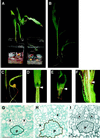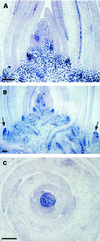Disruption of auxin transport is associated with aberrant leaf development in maize
- PMID: 10594103
- PMCID: PMC59483
- DOI: 10.1104/pp.121.4.1163
Disruption of auxin transport is associated with aberrant leaf development in maize
Abstract
Despite recent progress, the mechanisms governing shoot morphogenesis in higher plants are only partially understood. Classical physiological studies have suggested that gradients of the plant growth regulator auxin may play a role in controlling tissue differentiation in shoots. More recent molecular genetic studies have also identified knotted1 like homeobox (knox) genes as important regulators of shoot development. The maize (Zea mays L.) mutant rough sheath2 (rs2) displays ectopic expression of at least three knox genes and consequently conditions a range of shoot and leaf phenotypes, including aberrant vascular development, ligular displacements, and dwarfism (R. Schneeberger, M. Tsiantis, M. Freeling, J.A. Langdale [1998] Development 125: 2857-2865). In this report, we show that rs2 mutants also display decreased polar auxin transport in the shoot. We also demonstrate that germination of wild-type maize seedlings on agents known to inhibit polar auxin transport mimics aspects of the rs2 mutant phenotype. The phenotype elaborated in inhibitor-treated plants is not correlated with ectopic KNOX protein accumulation.
Figures




References
-
- Aloni R. The induction of vascular tissues by auxin and cytokinin. In: Davies PJ, editor. Plant Hormones: Physiology, Biochemistry and Molecular Biology. Dordrecht, The Netherlands: Kluwer Academic Publishers; 1995. pp. 531–546.
-
- Bennett SRM, Alvarez J, Bossinger G, Smyth DR. Morphogenesis in pinoid mutants of Arabidopsis thaliana. Plant J. 1995;8:505–520.
-
- Brutnell TP, Langdale JA. Signals in leaf development. Adv Bot Res. 1998;28:162–187.
-
- Carland FM, McHale NA. LOP1: a gene involved in auxin transport and vascular patterning in Arabidopsis. Development. 1996;122:1811–1819. - PubMed
LinkOut - more resources
Full Text Sources
Research Materials

